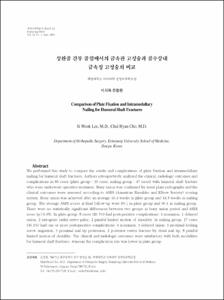상완골 간부 골절에서의 금속판 고정술과 골수강내 금속정 고정술의 비교
- Keimyung Author(s)
- Lee, Si Wook; Cho, Chul Hyun
- Department
- Dept. of Orthopedic Surgery (정형외과학)
- Journal Title
- Keimyung Medical Journal
- Issued Date
- 2013
- Volume
- 32
- Issue
- 1
- Keyword
- HumerusIntramedullary nailing; Plate; Shaft fracture
- Abstract
- We performed this study to compare the results and complications of plate fixation and intramedullary nailing for humeral shaft fractures. Authors retrospectively analyzed the clinical, radiologic outcomes and complications in 86 cases (plate group : 39 cases, nailing group : 47 cases) with humeral shaft fracture who were underwent operative treatment. Bony union was confirmed by serial plain radiographs and the clinical outcomes were assessed according to ASES (American Shoulder and Elbow Society) scoring system. Bony union was achieved after an average 16.4 weeks in plate group and 14.5 weeks in nailing group. The average ASES scores at final follow-up were 89.1 in plate group and 90.1 in nailing group. There were no statistically significant differences between two groups in bony union period and ASES score (p>0.05). In plate group, 8 cases (20.5%) had postoperative complications: 3 nonunion, 1 delayed union, 2 iatrogenic radial nerve palsy, 2 painful limited motion of shoulder. In nailing group, 17 cases (36.1%) had one or more postoperative complications: 6 nonunion, 3 delayed union, 3 proximal locking screw migration, 3 proximal nail tip protrusion, 2 posterior cortex fracture by distal nail tip, 8 painful limited motion of shoulder. The clinical and radiologic outcomes were satisfactory with both modalities for humeral shaft fractures, whereas the complication rate was lower in plate group.
- Alternative Title
- Comparison of Plate Fixation and Intramedullary Nailing for Humeral Shaft Fractures
- Publisher
- Keimyung University School of Medicine
- Citation
- 이시욱 and 조철현. (2013). 상완골 간부 골절에서의 금속판 고정술과 골수강내 금속정 고정술의 비교. Keimyung Medical Journal, 32(1), 36–42.
- Type
- Article
- Appears in Collections:
- 2. Keimyung Medical Journal (계명의대 학술지) > 2013
1. School of Medicine (의과대학) > Dept. of Orthopedic Surgery (정형외과학)
- 파일 목록
-
-
Download
 상완골 간부 골절에서의 금속판 고정술과 골수강내 금속정 고정술의 비교.pdf
기타 데이터 / 538.43 kB / Adobe PDF
상완골 간부 골절에서의 금속판 고정술과 골수강내 금속정 고정술의 비교.pdf
기타 데이터 / 538.43 kB / Adobe PDF
-
Items in Repository are protected by copyright, with all rights reserved, unless otherwise indicated.